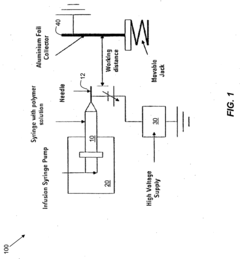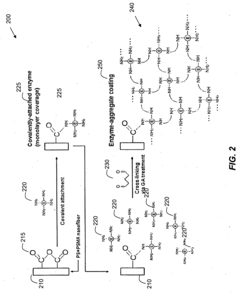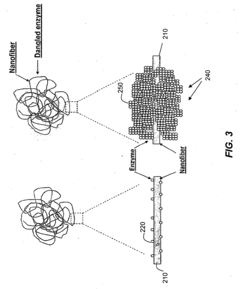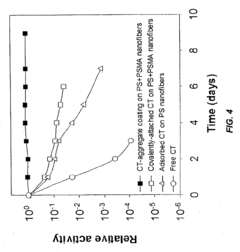Here is a suggested page title that meets the requirements: Exploring High Activity Materials - Eureka: Unveiling Cutting-Edge Discoveries
High Activity Materials Background and Objectives
Ultimately, the goal is to delineate a clear technological target or desired outcome that aligns with the strategic objectives and future aspirations of the enterprise, serving as a guiding beacon for subsequent research and development endeavors within this field.
Market Demand for High Activity Materials
- Growing Demand
The market for high activity materials is witnessing a surge in demand driven by advancements in various industries, including catalysis, energy storage, and environmental remediation. - Catalytic Applications
High activity materials find extensive applications in catalytic processes, enabling efficient chemical transformations and reducing energy consumption and emissions. - Energy Storage
The development of high-performance energy storage devices, such as batteries and supercapacitors, relies on the availability of high activity materials with enhanced electrochemical properties. - Environmental Remediation
High activity materials are crucial for environmental remediation processes, facilitating the removal of pollutants and contaminants from air, water, and soil. - Emerging Technologies
Emerging technologies, such as fuel cells, hydrogen production, and carbon capture, are driving the demand for high activity materials with tailored properties and improved performance.
Current State and Challenges of High Activity Materials
- Current Technological Landscape
The field of high activity materials is rapidly evolving, with researchers exploring various material compositions and structures to enhance catalytic performance, energy storage capabilities, and reactivity. - Key Challenges
- Stability and durability issues under harsh operating conditions
- Limited understanding of structure-activity relationships
- Scalability and cost-effectiveness of synthesis methods
- Geographical Distribution
Research efforts are distributed globally, with major contributions from academic and industrial institutions in the United States, Europe, China, and Japan.
Evolution Path of High Activity Materials

Current Solutions for High Activity Materials
01 High-activity carbon materials
Various methods for preparing high surface area and high activity carbon materials like activated carbon, graphite, and carbon nanofibers for applications like adsorption, catalysis, and energy storage.- High-activity carbon materials: Various methods for preparing high surface area and high activity carbon materials like activated carbon, carbon nanofibers, and graphite-phase carbon nitride for applications like adsorption, catalysis, and energy storage.
- High-activity catalytic materials: Techniques for synthesizing high-activity catalytic materials like metal oxides, composites, and modified materials with enhanced catalytic activity for various reactions like oxygen evolution, oxygen reduction, and electrochemical reactions in batteries.
- High-activity materials for bone regeneration: Methods for preparing high-activity composite materials and membranes that promote bone regeneration and repair, containing bioactive components like charged polymers or minerals with high osteogenic activity.
- High-activity materials from waste: Techniques for converting waste materials like coal gangue, red mud, and soil into high-activity materials through processes like activation, blending, and synergy for applications like adsorption, construction, and environmental remediation.
- High-activity materials for energy and environment: Methods for preparing high-activity materials for energy and environmental applications like thermal insulation, adsorption, and battery materials with properties like high surface activity, porosity, or specific functionalities.
02 High-activity composite materials
Composite materials with high catalytic, biological, or functional activity prepared by combining different components like metals, ceramics, polymers, and biomaterials for applications like catalysis, energy storage, and biomedical fields.03 High-activity electrode materials
Methods for preparing high-activity electrode materials like metal oxides, sulfides, and carbon-based materials for energy storage devices like batteries, supercapacitors, and fuel cells.04 High-activity building materials
Techniques for producing high-activity building materials like cement, concrete, and insulation materials with improved properties like strength, durability, and thermal insulation.05 High-activity materials for biomedical applications
Methods for preparing high-activity materials for biomedical applications like bone repair, drug delivery, and tissue engineering that promote cell growth, tissue regeneration, and have antimicrobial properties.
Key Players in High Activity Materials Industry
Battelle Memorial Institute
W. L. Gore & Associates, Inc.
Core Innovations in High Activity Materials
- The biocatalytic material includes functional groups on the surface covalently attached to functional groups of crosslinked enzymes and enzyme aggregates forming a biocatalytic coating, providing substantial stability.
- The activity and enzyme loading capacity of the biocatalytic material are greater than for a monolayer of enzymes.
- The biocatalytic material utilizes nanofibers which offer advantages such as reduced mass transfer limitations and ease of processing into various structures.










